Holmes Institute HI5015: Detailed Report on Nissan Motor v. USA Case
VerifiedAdded on 2023/01/18
|13
|2740
|44
Report
AI Summary
This report provides a comprehensive analysis of the Nissan Motor v. USA case, focusing on its implications for international trade law and customs duties. The report delves into the background of the dispute, the arguments presented by both sides, the legal issues involved, and the final verdict delivered by the United States Court of International Trade. It examines the significance of the case in shaping international trade regulations, particularly concerning the interpretation of the Foreign Trade Zones Act and the imposition of duties on imported machinery. The analysis highlights the limitations of the verdict, the impact on domestic industries, and the broader implications for future cases involving free trade zones and international trade disputes. The report also touches upon the impact of the case on protecting domestic industries from zonal competition. This case serves as a valuable reference point for understanding legal implications of operating within free trade zones.

Running head: NISSAN MOTOR V. USA
Nissan Motor v. USA
Name of Student:
Name of the University:
Author note:
Nissan Motor v. USA
Name of Student:
Name of the University:
Author note:
Paraphrase This Document
Need a fresh take? Get an instant paraphrase of this document with our AI Paraphraser
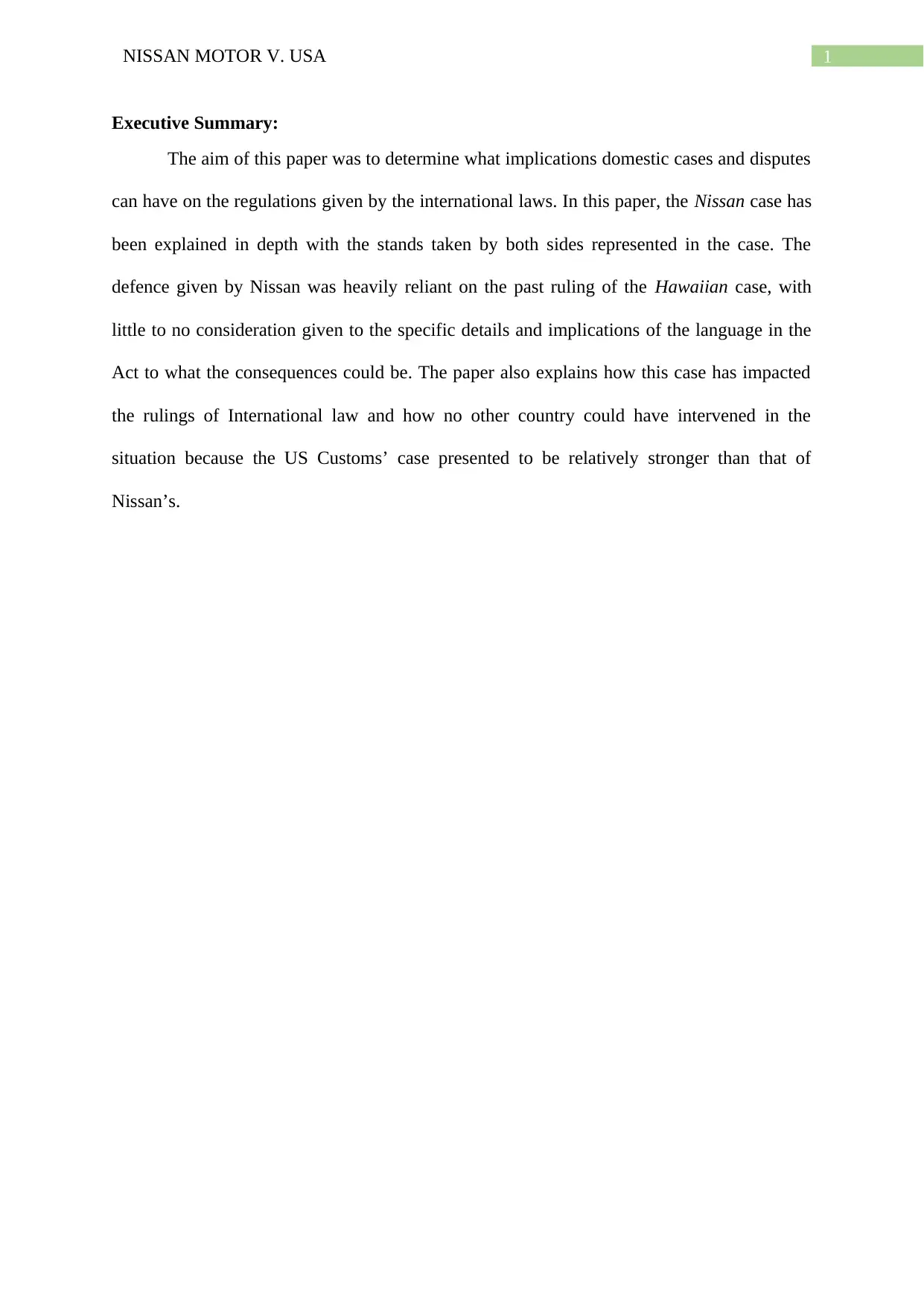
1NISSAN MOTOR V. USA
Executive Summary:
The aim of this paper was to determine what implications domestic cases and disputes
can have on the regulations given by the international laws. In this paper, the Nissan case has
been explained in depth with the stands taken by both sides represented in the case. The
defence given by Nissan was heavily reliant on the past ruling of the Hawaiian case, with
little to no consideration given to the specific details and implications of the language in the
Act to what the consequences could be. The paper also explains how this case has impacted
the rulings of International law and how no other country could have intervened in the
situation because the US Customs’ case presented to be relatively stronger than that of
Nissan’s.
Executive Summary:
The aim of this paper was to determine what implications domestic cases and disputes
can have on the regulations given by the international laws. In this paper, the Nissan case has
been explained in depth with the stands taken by both sides represented in the case. The
defence given by Nissan was heavily reliant on the past ruling of the Hawaiian case, with
little to no consideration given to the specific details and implications of the language in the
Act to what the consequences could be. The paper also explains how this case has impacted
the rulings of International law and how no other country could have intervened in the
situation because the US Customs’ case presented to be relatively stronger than that of
Nissan’s.
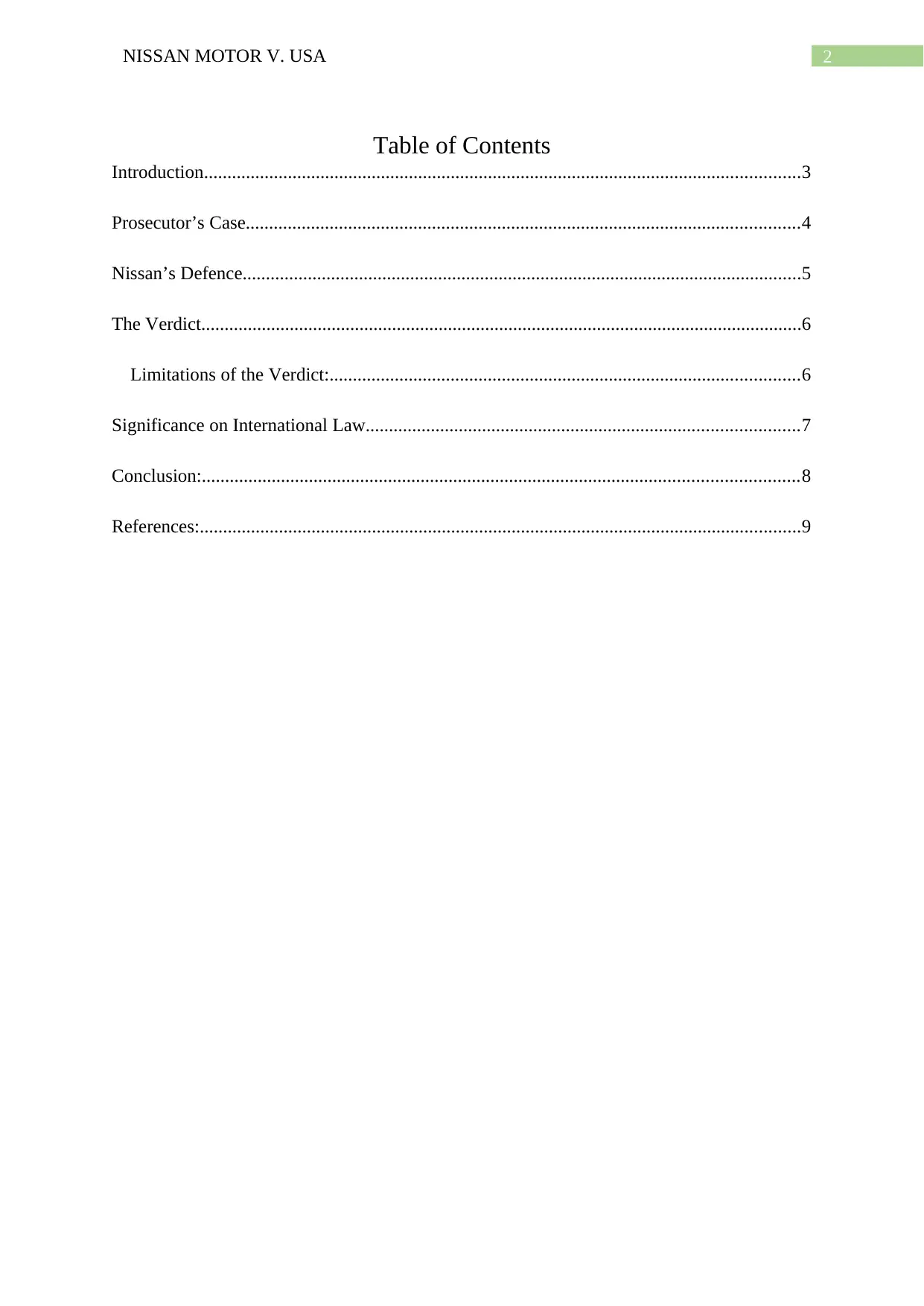
2NISSAN MOTOR V. USA
Table of Contents
Introduction................................................................................................................................3
Prosecutor’s Case.......................................................................................................................4
Nissan’s Defence........................................................................................................................5
The Verdict.................................................................................................................................6
Limitations of the Verdict:.....................................................................................................6
Significance on International Law.............................................................................................7
Conclusion:................................................................................................................................8
References:.................................................................................................................................9
Table of Contents
Introduction................................................................................................................................3
Prosecutor’s Case.......................................................................................................................4
Nissan’s Defence........................................................................................................................5
The Verdict.................................................................................................................................6
Limitations of the Verdict:.....................................................................................................6
Significance on International Law.............................................................................................7
Conclusion:................................................................................................................................8
References:.................................................................................................................................9
⊘ This is a preview!⊘
Do you want full access?
Subscribe today to unlock all pages.

Trusted by 1+ million students worldwide

3NISSAN MOTOR V. USA
Introduction
The case of Nissan Motor v. USA is about the judgment declared by the United States
Court of International Trade stating that Nissan was making use of as well as holding
machinery that was imported from Japan into a foreign trading zone subzone. The US
Customs Laws had stated that these machines were being used for production purposes as
well as were subject to experiencing duty charges.
The establishment of a foreign trade zone is to designate areas within the country that will
not be considered to be under the territory of that country, and hence outside the zone of the
Customs Duty. As a result, any foreign merchandise can be brought into those specified
zones without the organization bringing them in having to pay any money in duty (Qurashi
and Luqmani 2015). These zone are legally authorized by the government of that country and
are allowed to be used for purposes such as assembling, repackaging as well as the storing of
foreign merchandise (Qurashi and Luqmani 2015). It is important to note that the fact that
Nissan was operating in a subzone added a layer of more requirements as these types of zones
are inherently independent of the foreign trade zone and it is only authorized for specific
purposes while being able to retain the benefits that come from a free trade zone. The activity
in the subzone is usually only carried out by one specific company (Qurashi and Luqmani
2015).
The machinery that Nissan imported into the subzone was consisted of highly automated
as well as the integrated systems along with automated conveyor systems, all of which were
required to be operated by a computerized interface. Since Nissan executives were aware that
they would be operating in the subzone, they had requested a ruling from the Customs
department of the US for their obligation regarding the applicable duties to be charged on the
machinery that they were bringing in (USITC, 1984).
Introduction
The case of Nissan Motor v. USA is about the judgment declared by the United States
Court of International Trade stating that Nissan was making use of as well as holding
machinery that was imported from Japan into a foreign trading zone subzone. The US
Customs Laws had stated that these machines were being used for production purposes as
well as were subject to experiencing duty charges.
The establishment of a foreign trade zone is to designate areas within the country that will
not be considered to be under the territory of that country, and hence outside the zone of the
Customs Duty. As a result, any foreign merchandise can be brought into those specified
zones without the organization bringing them in having to pay any money in duty (Qurashi
and Luqmani 2015). These zone are legally authorized by the government of that country and
are allowed to be used for purposes such as assembling, repackaging as well as the storing of
foreign merchandise (Qurashi and Luqmani 2015). It is important to note that the fact that
Nissan was operating in a subzone added a layer of more requirements as these types of zones
are inherently independent of the foreign trade zone and it is only authorized for specific
purposes while being able to retain the benefits that come from a free trade zone. The activity
in the subzone is usually only carried out by one specific company (Qurashi and Luqmani
2015).
The machinery that Nissan imported into the subzone was consisted of highly automated
as well as the integrated systems along with automated conveyor systems, all of which were
required to be operated by a computerized interface. Since Nissan executives were aware that
they would be operating in the subzone, they had requested a ruling from the Customs
department of the US for their obligation regarding the applicable duties to be charged on the
machinery that they were bringing in (USITC, 1984).
Paraphrase This Document
Need a fresh take? Get an instant paraphrase of this document with our AI Paraphraser
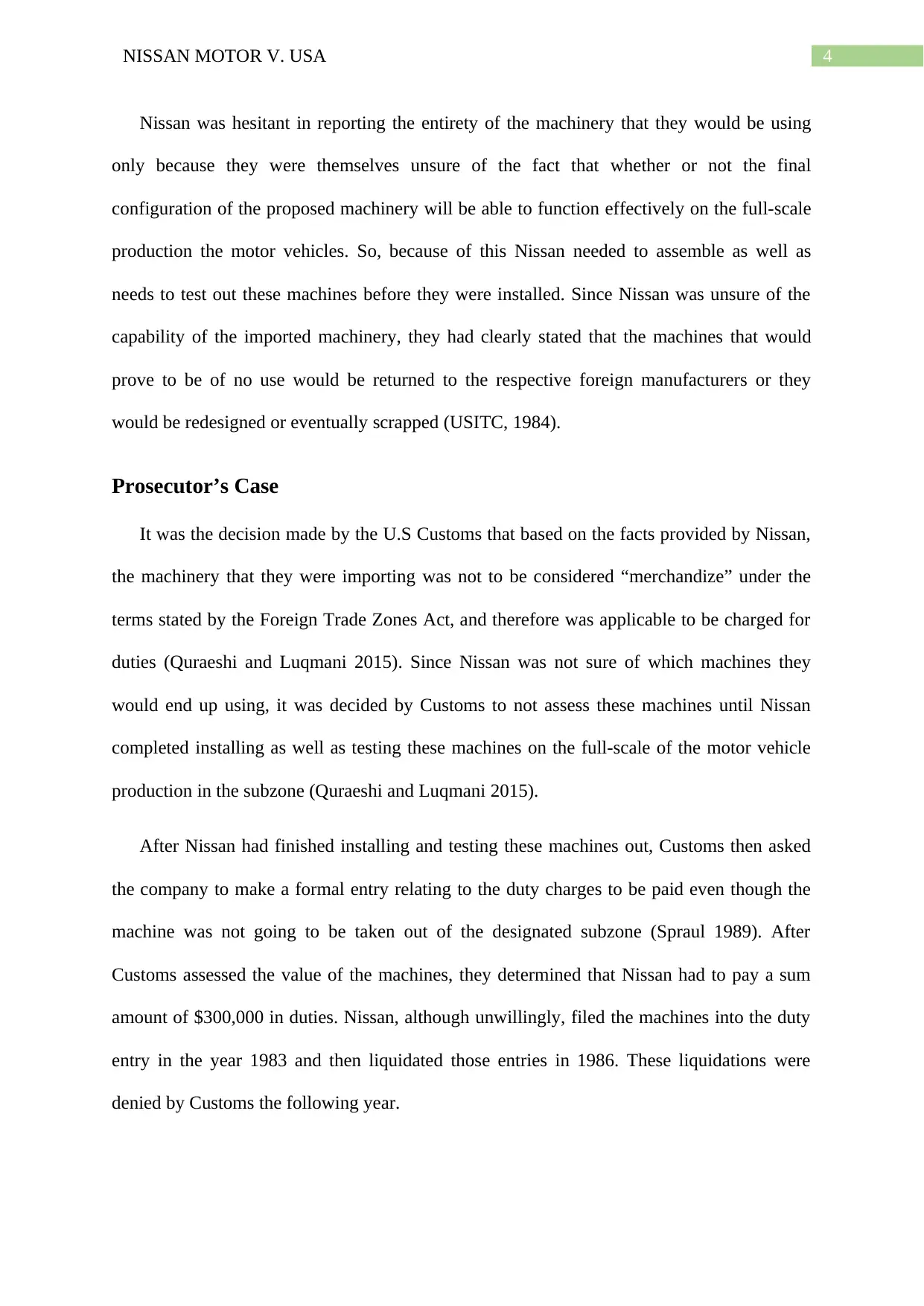
4NISSAN MOTOR V. USA
Nissan was hesitant in reporting the entirety of the machinery that they would be using
only because they were themselves unsure of the fact that whether or not the final
configuration of the proposed machinery will be able to function effectively on the full-scale
production the motor vehicles. So, because of this Nissan needed to assemble as well as
needs to test out these machines before they were installed. Since Nissan was unsure of the
capability of the imported machinery, they had clearly stated that the machines that would
prove to be of no use would be returned to the respective foreign manufacturers or they
would be redesigned or eventually scrapped (USITC, 1984).
Prosecutor’s Case
It was the decision made by the U.S Customs that based on the facts provided by Nissan,
the machinery that they were importing was not to be considered “merchandize” under the
terms stated by the Foreign Trade Zones Act, and therefore was applicable to be charged for
duties (Quraeshi and Luqmani 2015). Since Nissan was not sure of which machines they
would end up using, it was decided by Customs to not assess these machines until Nissan
completed installing as well as testing these machines on the full-scale of the motor vehicle
production in the subzone (Quraeshi and Luqmani 2015).
After Nissan had finished installing and testing these machines out, Customs then asked
the company to make a formal entry relating to the duty charges to be paid even though the
machine was not going to be taken out of the designated subzone (Spraul 1989). After
Customs assessed the value of the machines, they determined that Nissan had to pay a sum
amount of $300,000 in duties. Nissan, although unwillingly, filed the machines into the duty
entry in the year 1983 and then liquidated those entries in 1986. These liquidations were
denied by Customs the following year.
Nissan was hesitant in reporting the entirety of the machinery that they would be using
only because they were themselves unsure of the fact that whether or not the final
configuration of the proposed machinery will be able to function effectively on the full-scale
production the motor vehicles. So, because of this Nissan needed to assemble as well as
needs to test out these machines before they were installed. Since Nissan was unsure of the
capability of the imported machinery, they had clearly stated that the machines that would
prove to be of no use would be returned to the respective foreign manufacturers or they
would be redesigned or eventually scrapped (USITC, 1984).
Prosecutor’s Case
It was the decision made by the U.S Customs that based on the facts provided by Nissan,
the machinery that they were importing was not to be considered “merchandize” under the
terms stated by the Foreign Trade Zones Act, and therefore was applicable to be charged for
duties (Quraeshi and Luqmani 2015). Since Nissan was not sure of which machines they
would end up using, it was decided by Customs to not assess these machines until Nissan
completed installing as well as testing these machines on the full-scale of the motor vehicle
production in the subzone (Quraeshi and Luqmani 2015).
After Nissan had finished installing and testing these machines out, Customs then asked
the company to make a formal entry relating to the duty charges to be paid even though the
machine was not going to be taken out of the designated subzone (Spraul 1989). After
Customs assessed the value of the machines, they determined that Nissan had to pay a sum
amount of $300,000 in duties. Nissan, although unwillingly, filed the machines into the duty
entry in the year 1983 and then liquidated those entries in 1986. These liquidations were
denied by Customs the following year.

5NISSAN MOTOR V. USA
The US government further addresses the fact that the Foreign Trade Zone Act does not
promote opportunities of avoiding or deferring payment of duties when equipment is installed
as well as was made use of within the borders of the designated foreign trade zone. These
machineries cannot be considered as “merchandise” within the guidelines given by the Act.
Nissan’s Defence
According to Nissan, the trial in court had a major flaw in concluding that Customs
were liable to charge the company for the imposing of duty on the machinery. This is because
according to facts, the Customs will only intervene when an organization is functioning in
areas that are considered to be outside the foreign trade zone, which Nissan was not doing.
Nissan was functioning and maintaining their machinery as well as the factory processes
inside the given geographical borders of the foreign trade zone. Nissan furthers their protest
against US Customs with claims of the fact that the merchandize that entered into the
subzone never even left that area, forget the fact that the machinery entered the territory that
may have been under the Customs designation (Vuori 2015).
Nissan relied on the case of Hawaiian Independent Refinery v. United States to
strengthen their claim and have grounds of argument that the machinery that they have
imported into the subzone should be exempt from charges related to Customs duty. In the
case of Hawaiian Independent Refinery, they claimed exemption from duty for the crude oil
that they imported for the purpose of fuel usage within the boundaries of the subzone.
However, this was contended by the court ruling of the Nissan case by saying that under the
sections of the Foreign Trade Act, the crude oil was understood to be merchandise. However,
the machinery imported by Nissan was concluded to be not considerable of being under the
terms of “merchandize” and was also not able to comply with the comprehensive list of duty-
free products (USITC, 1984).
The US government further addresses the fact that the Foreign Trade Zone Act does not
promote opportunities of avoiding or deferring payment of duties when equipment is installed
as well as was made use of within the borders of the designated foreign trade zone. These
machineries cannot be considered as “merchandise” within the guidelines given by the Act.
Nissan’s Defence
According to Nissan, the trial in court had a major flaw in concluding that Customs
were liable to charge the company for the imposing of duty on the machinery. This is because
according to facts, the Customs will only intervene when an organization is functioning in
areas that are considered to be outside the foreign trade zone, which Nissan was not doing.
Nissan was functioning and maintaining their machinery as well as the factory processes
inside the given geographical borders of the foreign trade zone. Nissan furthers their protest
against US Customs with claims of the fact that the merchandize that entered into the
subzone never even left that area, forget the fact that the machinery entered the territory that
may have been under the Customs designation (Vuori 2015).
Nissan relied on the case of Hawaiian Independent Refinery v. United States to
strengthen their claim and have grounds of argument that the machinery that they have
imported into the subzone should be exempt from charges related to Customs duty. In the
case of Hawaiian Independent Refinery, they claimed exemption from duty for the crude oil
that they imported for the purpose of fuel usage within the boundaries of the subzone.
However, this was contended by the court ruling of the Nissan case by saying that under the
sections of the Foreign Trade Act, the crude oil was understood to be merchandise. However,
the machinery imported by Nissan was concluded to be not considerable of being under the
terms of “merchandize” and was also not able to comply with the comprehensive list of duty-
free products (USITC, 1984).
⊘ This is a preview!⊘
Do you want full access?
Subscribe today to unlock all pages.

Trusted by 1+ million students worldwide
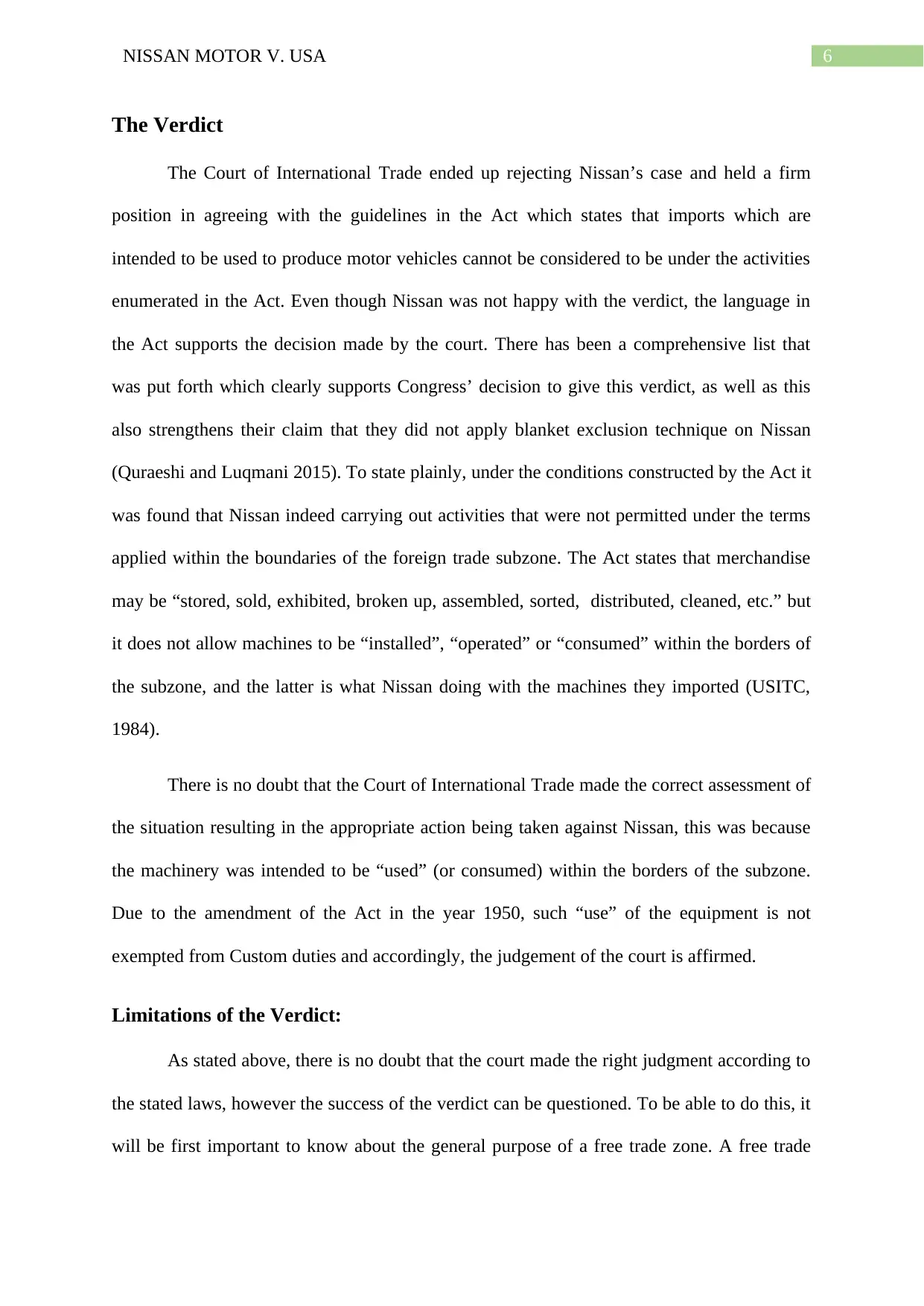
6NISSAN MOTOR V. USA
The Verdict
The Court of International Trade ended up rejecting Nissan’s case and held a firm
position in agreeing with the guidelines in the Act which states that imports which are
intended to be used to produce motor vehicles cannot be considered to be under the activities
enumerated in the Act. Even though Nissan was not happy with the verdict, the language in
the Act supports the decision made by the court. There has been a comprehensive list that
was put forth which clearly supports Congress’ decision to give this verdict, as well as this
also strengthens their claim that they did not apply blanket exclusion technique on Nissan
(Quraeshi and Luqmani 2015). To state plainly, under the conditions constructed by the Act it
was found that Nissan indeed carrying out activities that were not permitted under the terms
applied within the boundaries of the foreign trade subzone. The Act states that merchandise
may be “stored, sold, exhibited, broken up, assembled, sorted, distributed, cleaned, etc.” but
it does not allow machines to be “installed”, “operated” or “consumed” within the borders of
the subzone, and the latter is what Nissan doing with the machines they imported (USITC,
1984).
There is no doubt that the Court of International Trade made the correct assessment of
the situation resulting in the appropriate action being taken against Nissan, this was because
the machinery was intended to be “used” (or consumed) within the borders of the subzone.
Due to the amendment of the Act in the year 1950, such “use” of the equipment is not
exempted from Custom duties and accordingly, the judgement of the court is affirmed.
Limitations of the Verdict:
As stated above, there is no doubt that the court made the right judgment according to
the stated laws, however the success of the verdict can be questioned. To be able to do this, it
will be first important to know about the general purpose of a free trade zone. A free trade
The Verdict
The Court of International Trade ended up rejecting Nissan’s case and held a firm
position in agreeing with the guidelines in the Act which states that imports which are
intended to be used to produce motor vehicles cannot be considered to be under the activities
enumerated in the Act. Even though Nissan was not happy with the verdict, the language in
the Act supports the decision made by the court. There has been a comprehensive list that
was put forth which clearly supports Congress’ decision to give this verdict, as well as this
also strengthens their claim that they did not apply blanket exclusion technique on Nissan
(Quraeshi and Luqmani 2015). To state plainly, under the conditions constructed by the Act it
was found that Nissan indeed carrying out activities that were not permitted under the terms
applied within the boundaries of the foreign trade subzone. The Act states that merchandise
may be “stored, sold, exhibited, broken up, assembled, sorted, distributed, cleaned, etc.” but
it does not allow machines to be “installed”, “operated” or “consumed” within the borders of
the subzone, and the latter is what Nissan doing with the machines they imported (USITC,
1984).
There is no doubt that the Court of International Trade made the correct assessment of
the situation resulting in the appropriate action being taken against Nissan, this was because
the machinery was intended to be “used” (or consumed) within the borders of the subzone.
Due to the amendment of the Act in the year 1950, such “use” of the equipment is not
exempted from Custom duties and accordingly, the judgement of the court is affirmed.
Limitations of the Verdict:
As stated above, there is no doubt that the court made the right judgment according to
the stated laws, however the success of the verdict can be questioned. To be able to do this, it
will be first important to know about the general purpose of a free trade zone. A free trade
Paraphrase This Document
Need a fresh take? Get an instant paraphrase of this document with our AI Paraphraser
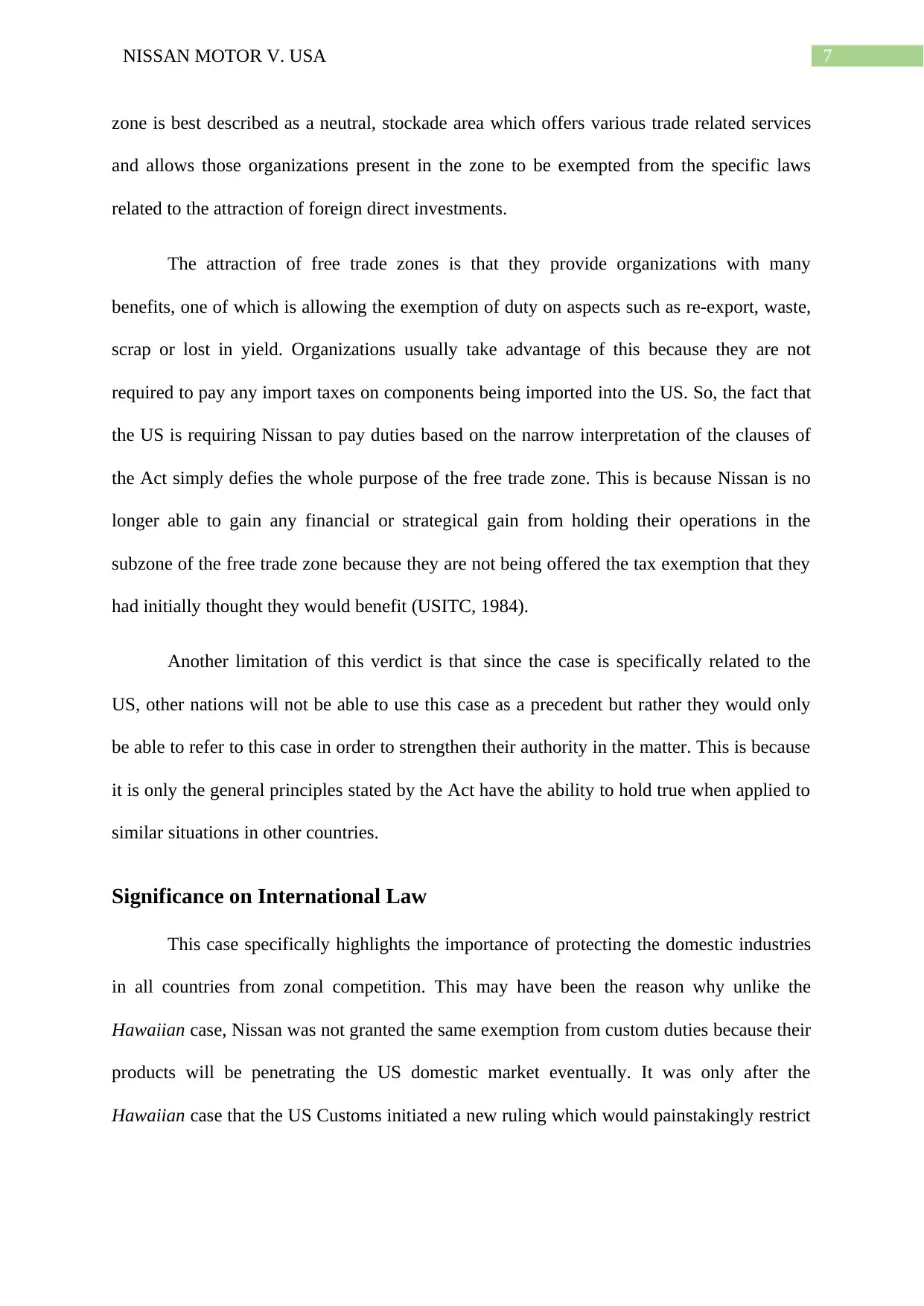
7NISSAN MOTOR V. USA
zone is best described as a neutral, stockade area which offers various trade related services
and allows those organizations present in the zone to be exempted from the specific laws
related to the attraction of foreign direct investments.
The attraction of free trade zones is that they provide organizations with many
benefits, one of which is allowing the exemption of duty on aspects such as re-export, waste,
scrap or lost in yield. Organizations usually take advantage of this because they are not
required to pay any import taxes on components being imported into the US. So, the fact that
the US is requiring Nissan to pay duties based on the narrow interpretation of the clauses of
the Act simply defies the whole purpose of the free trade zone. This is because Nissan is no
longer able to gain any financial or strategical gain from holding their operations in the
subzone of the free trade zone because they are not being offered the tax exemption that they
had initially thought they would benefit (USITC, 1984).
Another limitation of this verdict is that since the case is specifically related to the
US, other nations will not be able to use this case as a precedent but rather they would only
be able to refer to this case in order to strengthen their authority in the matter. This is because
it is only the general principles stated by the Act have the ability to hold true when applied to
similar situations in other countries.
Significance on International Law
This case specifically highlights the importance of protecting the domestic industries
in all countries from zonal competition. This may have been the reason why unlike the
Hawaiian case, Nissan was not granted the same exemption from custom duties because their
products will be penetrating the US domestic market eventually. It was only after the
Hawaiian case that the US Customs initiated a new ruling which would painstakingly restrict
zone is best described as a neutral, stockade area which offers various trade related services
and allows those organizations present in the zone to be exempted from the specific laws
related to the attraction of foreign direct investments.
The attraction of free trade zones is that they provide organizations with many
benefits, one of which is allowing the exemption of duty on aspects such as re-export, waste,
scrap or lost in yield. Organizations usually take advantage of this because they are not
required to pay any import taxes on components being imported into the US. So, the fact that
the US is requiring Nissan to pay duties based on the narrow interpretation of the clauses of
the Act simply defies the whole purpose of the free trade zone. This is because Nissan is no
longer able to gain any financial or strategical gain from holding their operations in the
subzone of the free trade zone because they are not being offered the tax exemption that they
had initially thought they would benefit (USITC, 1984).
Another limitation of this verdict is that since the case is specifically related to the
US, other nations will not be able to use this case as a precedent but rather they would only
be able to refer to this case in order to strengthen their authority in the matter. This is because
it is only the general principles stated by the Act have the ability to hold true when applied to
similar situations in other countries.
Significance on International Law
This case specifically highlights the importance of protecting the domestic industries
in all countries from zonal competition. This may have been the reason why unlike the
Hawaiian case, Nissan was not granted the same exemption from custom duties because their
products will be penetrating the US domestic market eventually. It was only after the
Hawaiian case that the US Customs initiated a new ruling which would painstakingly restrict
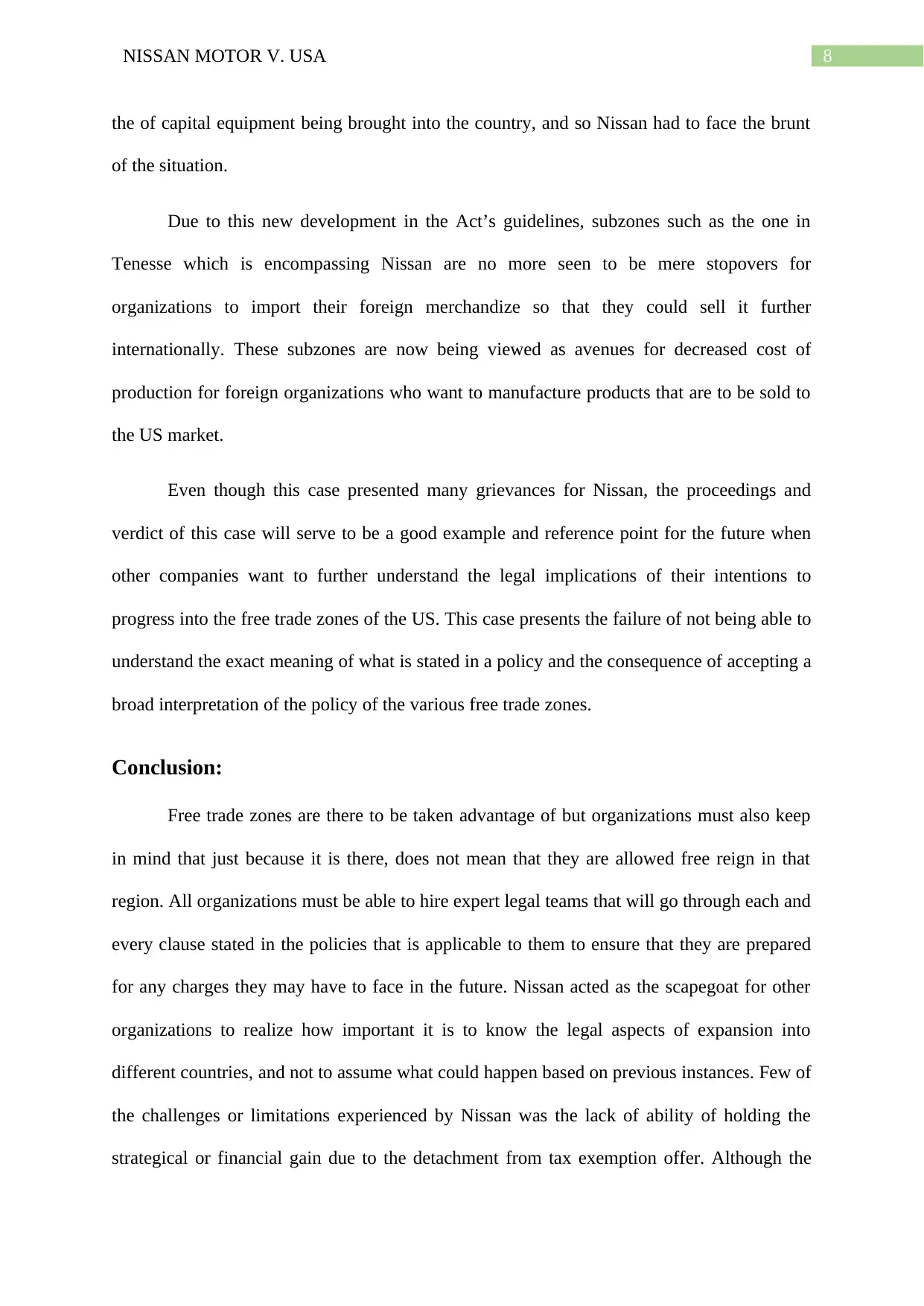
8NISSAN MOTOR V. USA
the of capital equipment being brought into the country, and so Nissan had to face the brunt
of the situation.
Due to this new development in the Act’s guidelines, subzones such as the one in
Tenesse which is encompassing Nissan are no more seen to be mere stopovers for
organizations to import their foreign merchandize so that they could sell it further
internationally. These subzones are now being viewed as avenues for decreased cost of
production for foreign organizations who want to manufacture products that are to be sold to
the US market.
Even though this case presented many grievances for Nissan, the proceedings and
verdict of this case will serve to be a good example and reference point for the future when
other companies want to further understand the legal implications of their intentions to
progress into the free trade zones of the US. This case presents the failure of not being able to
understand the exact meaning of what is stated in a policy and the consequence of accepting a
broad interpretation of the policy of the various free trade zones.
Conclusion:
Free trade zones are there to be taken advantage of but organizations must also keep
in mind that just because it is there, does not mean that they are allowed free reign in that
region. All organizations must be able to hire expert legal teams that will go through each and
every clause stated in the policies that is applicable to them to ensure that they are prepared
for any charges they may have to face in the future. Nissan acted as the scapegoat for other
organizations to realize how important it is to know the legal aspects of expansion into
different countries, and not to assume what could happen based on previous instances. Few of
the challenges or limitations experienced by Nissan was the lack of ability of holding the
strategical or financial gain due to the detachment from tax exemption offer. Although the
the of capital equipment being brought into the country, and so Nissan had to face the brunt
of the situation.
Due to this new development in the Act’s guidelines, subzones such as the one in
Tenesse which is encompassing Nissan are no more seen to be mere stopovers for
organizations to import their foreign merchandize so that they could sell it further
internationally. These subzones are now being viewed as avenues for decreased cost of
production for foreign organizations who want to manufacture products that are to be sold to
the US market.
Even though this case presented many grievances for Nissan, the proceedings and
verdict of this case will serve to be a good example and reference point for the future when
other companies want to further understand the legal implications of their intentions to
progress into the free trade zones of the US. This case presents the failure of not being able to
understand the exact meaning of what is stated in a policy and the consequence of accepting a
broad interpretation of the policy of the various free trade zones.
Conclusion:
Free trade zones are there to be taken advantage of but organizations must also keep
in mind that just because it is there, does not mean that they are allowed free reign in that
region. All organizations must be able to hire expert legal teams that will go through each and
every clause stated in the policies that is applicable to them to ensure that they are prepared
for any charges they may have to face in the future. Nissan acted as the scapegoat for other
organizations to realize how important it is to know the legal aspects of expansion into
different countries, and not to assume what could happen based on previous instances. Few of
the challenges or limitations experienced by Nissan was the lack of ability of holding the
strategical or financial gain due to the detachment from tax exemption offer. Although the
⊘ This is a preview!⊘
Do you want full access?
Subscribe today to unlock all pages.

Trusted by 1+ million students worldwide
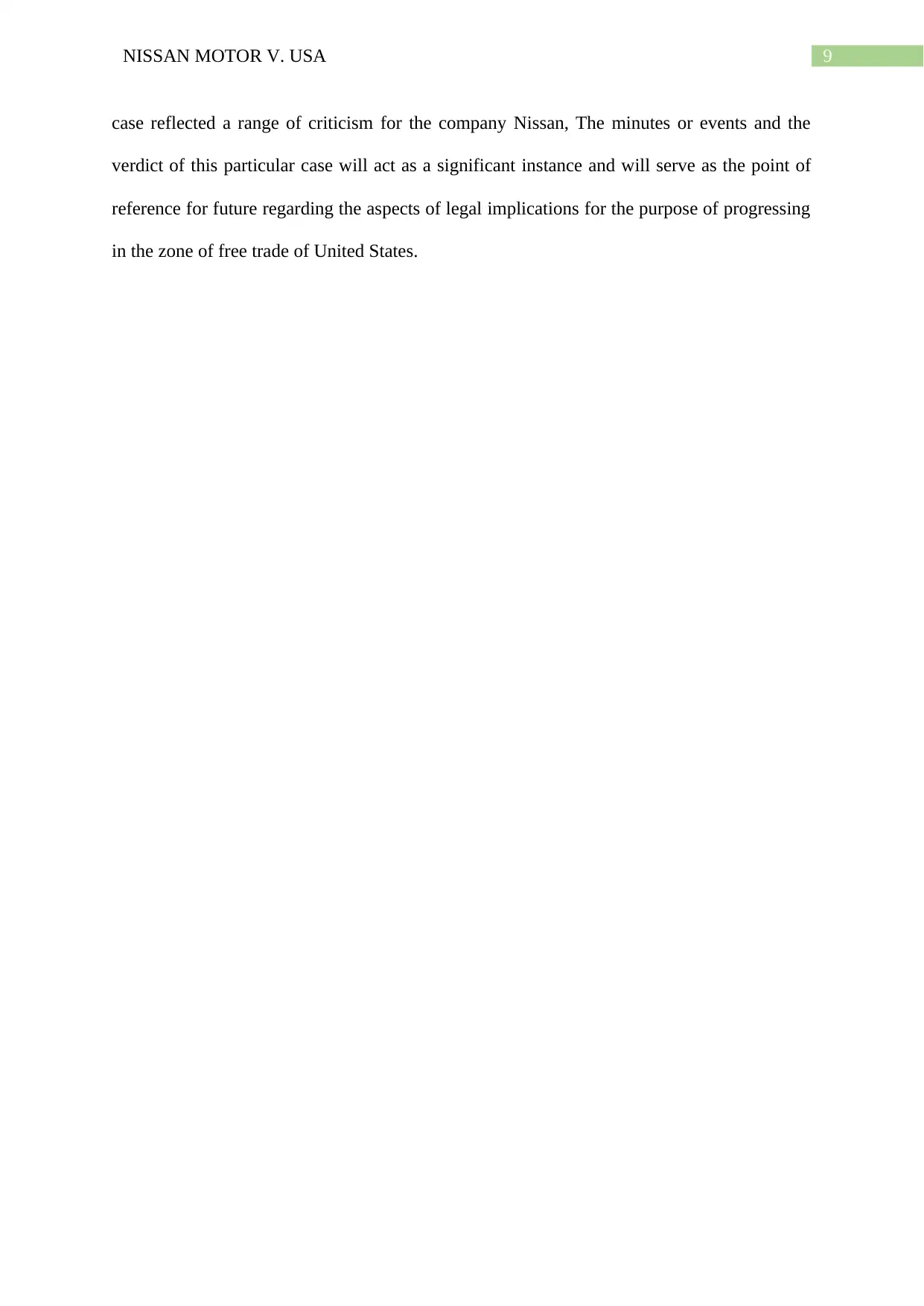
9NISSAN MOTOR V. USA
case reflected a range of criticism for the company Nissan, The minutes or events and the
verdict of this particular case will act as a significant instance and will serve as the point of
reference for future regarding the aspects of legal implications for the purpose of progressing
in the zone of free trade of United States.
case reflected a range of criticism for the company Nissan, The minutes or events and the
verdict of this particular case will act as a significant instance and will serve as the point of
reference for future regarding the aspects of legal implications for the purpose of progressing
in the zone of free trade of United States.
Paraphrase This Document
Need a fresh take? Get an instant paraphrase of this document with our AI Paraphraser
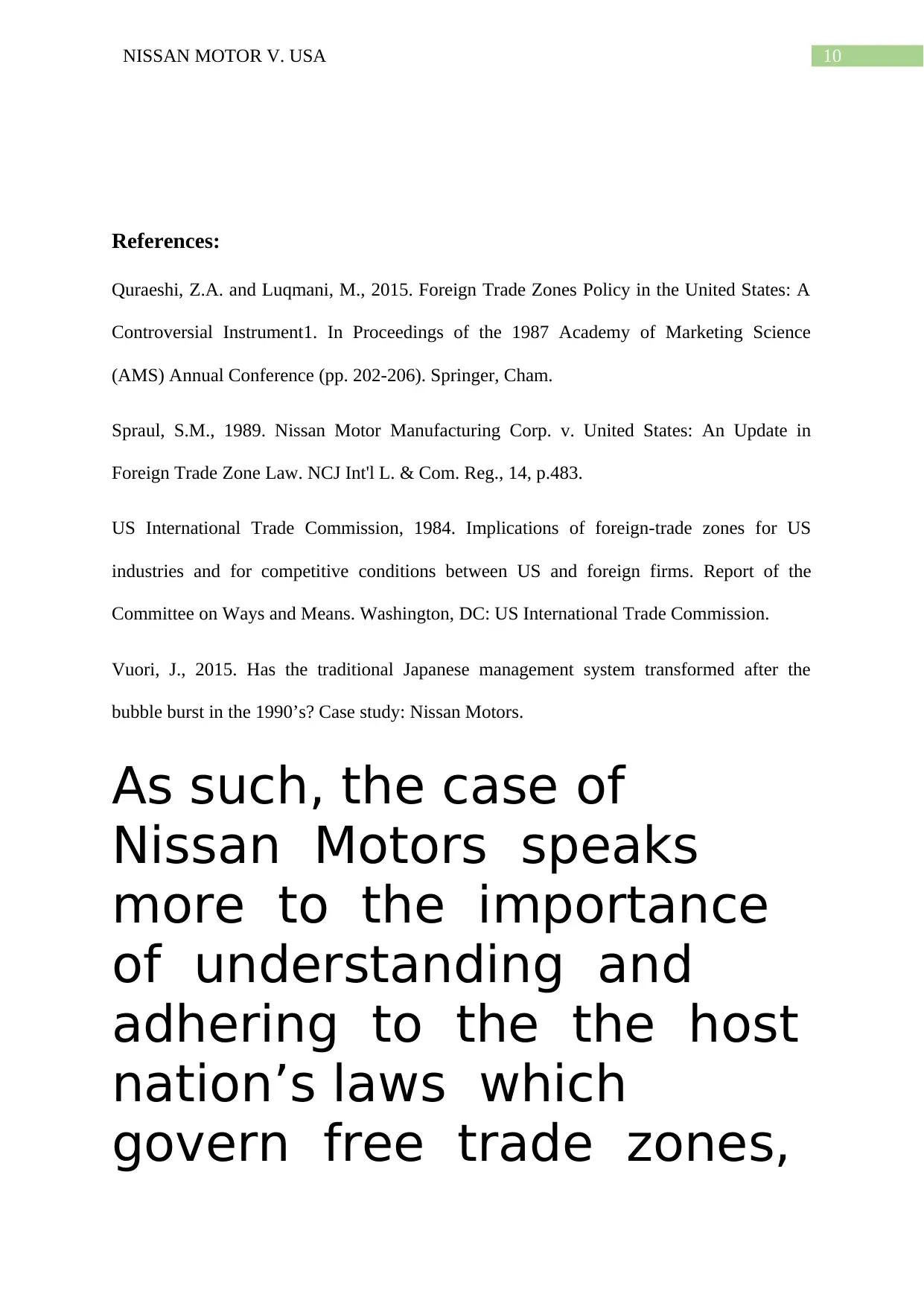
10NISSAN MOTOR V. USA
References:
Quraeshi, Z.A. and Luqmani, M., 2015. Foreign Trade Zones Policy in the United States: A
Controversial Instrument1. In Proceedings of the 1987 Academy of Marketing Science
(AMS) Annual Conference (pp. 202-206). Springer, Cham.
Spraul, S.M., 1989. Nissan Motor Manufacturing Corp. v. United States: An Update in
Foreign Trade Zone Law. NCJ Int'l L. & Com. Reg., 14, p.483.
US International Trade Commission, 1984. Implications of foreign-trade zones for US
industries and for competitive conditions between US and foreign firms. Report of the
Committee on Ways and Means. Washington, DC: US International Trade Commission.
Vuori, J., 2015. Has the traditional Japanese management system transformed after the
bubble burst in the 1990’s? Case study: Nissan Motors.
As such, the case of
Nissan Motors speaks
more to the importance
of understanding and
adhering to the the host
nation’s laws which
govern free trade zones,
References:
Quraeshi, Z.A. and Luqmani, M., 2015. Foreign Trade Zones Policy in the United States: A
Controversial Instrument1. In Proceedings of the 1987 Academy of Marketing Science
(AMS) Annual Conference (pp. 202-206). Springer, Cham.
Spraul, S.M., 1989. Nissan Motor Manufacturing Corp. v. United States: An Update in
Foreign Trade Zone Law. NCJ Int'l L. & Com. Reg., 14, p.483.
US International Trade Commission, 1984. Implications of foreign-trade zones for US
industries and for competitive conditions between US and foreign firms. Report of the
Committee on Ways and Means. Washington, DC: US International Trade Commission.
Vuori, J., 2015. Has the traditional Japanese management system transformed after the
bubble burst in the 1990’s? Case study: Nissan Motors.
As such, the case of
Nissan Motors speaks
more to the importance
of understanding and
adhering to the the host
nation’s laws which
govern free trade zones,

11NISSAN MOTOR V. USA
as opposed to any
broad interpretation
which may
point to defect in the
foreign trade zone system
itself
As such, the case of
Nissan Motors speaks
more to the importance
of understanding and
adhering to the the host
nation’s laws which
govern free trade zones,
as opposed to any
broad interpretation
which may
as opposed to any
broad interpretation
which may
point to defect in the
foreign trade zone system
itself
As such, the case of
Nissan Motors speaks
more to the importance
of understanding and
adhering to the the host
nation’s laws which
govern free trade zones,
as opposed to any
broad interpretation
which may
⊘ This is a preview!⊘
Do you want full access?
Subscribe today to unlock all pages.

Trusted by 1+ million students worldwide
1 out of 13
Related Documents
Your All-in-One AI-Powered Toolkit for Academic Success.
+13062052269
info@desklib.com
Available 24*7 on WhatsApp / Email
![[object Object]](/_next/static/media/star-bottom.7253800d.svg)
Unlock your academic potential
Copyright © 2020–2025 A2Z Services. All Rights Reserved. Developed and managed by ZUCOL.



